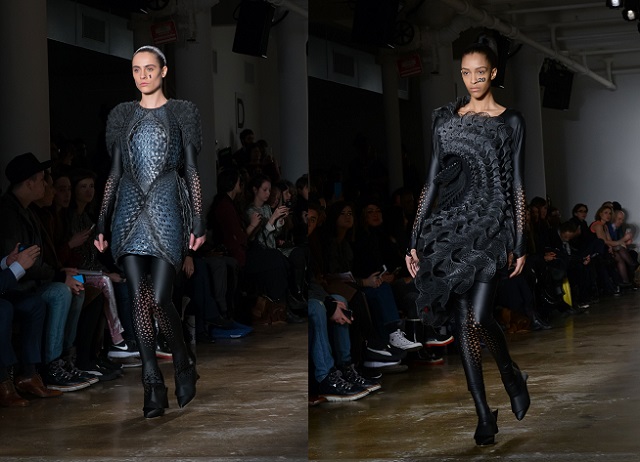Feb 17 2016
Stratasys, a 3D printing and additive manufacturing solutions company, has partnered with high-end fashion designers, threeASFOUR, and New York-based designer Travis Fitch to produce two exclusive futuristic 3D printed dresses using the breakthrough Stratasys 3D printing technology.
 Left: 3D Printed Pangolin Dress Right: 3D Printed Harmonograph Dress Photo credit: Matt Carasella
Left: 3D Printed Pangolin Dress Right: 3D Printed Harmonograph Dress Photo credit: Matt Carasella
As part of New York Fashion Week, the two dresses ‘Pangolin' and ‘Harmonograph' were showcased at threeASFOUR's Fall/Winter Runway Show, at Milk Studios, New York on Monday, 15th February 2016. Both of the dresses are a part of the highly awaited 'Biomimicry' collection from threeASFOUR. The dresses were made using Stratasys' Objet500 Connex3 3D Printer, which is equipped with the unique multi-material multi-color 3D printing technology.
The 3D printed dresses are the first use of Stratasys unique Nano Enhanced Elastomeric Technology material. This highly flexible and durable material is a giant leap forward for 3D printed fashion design. The material can be incorporated into several other applications and industries, such as consumer goods, automotive, medical devices, and consumer electronics.
threeASFOUR designers, Gabi Asfour, Angela Donhauser, and Adi Gil, are famous for their work with intricate designs and advanced materials, and their latest collection reflect the natural geometries of their surroundings. The two 3D printed dresses reflect the way natural morphologies and biological forms can be imitated in fashion using 3D printing.
Having the capability to vary color and rigidity in a single piece using Stratasys' Connex3 3D printing technology inspired us to explore flexibility, depth and transformation as inherent design objectives. As artists and designers, it is our prerogative - and our nature - to explore the bounds of new technological opportunities, and to push the limits of the way in which forms are created. As the most advanced 3D printed dresses that we have created to date, we are extremely excited to showcase these pieces and demonstrate the unique possibilities unfolding at the intersection of fashion, design and technology.
Adi Gill, threeASFOUR
The Harmonograph dress entwines around the body in three spirals, replicating the geometry of the Fibonacci sequence, and optically portraying the effect of a harmonograph.
Stratasys Defines New Movement in 3D Printed Fashion at New York Fashion Week
Gil explains that the designs, which integrated biology, geometry, and logarithms, were based on the new opportunities that Stratasys’ multi-color, multi-material 3D printing was able to offer, such as the capability to blend together rigid with rubber materials to realize any level of flexibility, in any color, within a particular print.
"Not only were the 3D printing capabilities of the Objet500 Connex3 essential in the production of the dress, but the entire design from its initial conception was intended to maximize the potentials inherent to this technology. The interwoven nature of the geometry could not be produced in a traditional manner, and it was critical to us that the design should evoke a language unique to 3D printing."
The Pangolin dress, a signature threeASFOUR design, has 14 pattern pieces. This 3D printed dress was produced by blending a number of interlocking weaves, to biomimic natural animal textures. The Objet500 Connex3 3D Printer provided the accuracy and ability to contrast material properties, such as color gradation and rigidity, and enabled the designers to have geometric control to produce nuanced, consciously placed transformations in the membrane's flexibility and porosity. It gave the designers the opportunity to create alternating states of privacy and transparency, and at the same time allow movement according to the human body.
This fashion design partnership with threeASFOUR is the most current project in a series of high-profile fashion and design collaborations for Stratasys, which have included Prof. Neri Oxman, Iris van Herpen, Francis Bitonti, Julia Koerner, Eyal Gever, Nick Ervinck, Zaha Hadid Architects and others.
We are always looking to revolutionize manufacturing methods, pioneer new design options, and inspire designers and students to create avant-garde expressions of fashion. Collaborative projects with talented and visionary designers, such as threeASFOUR, are the ideal way to showcase to aspiring designers, students and creatives the types of organic and complex mathematical structures that can become a physical reality with 3D printing. Our mission is to change the way people think about design and to redefine its possibilities.
Naomi Kaempfer, Creative Director, Art Fashion Design, Stratasys